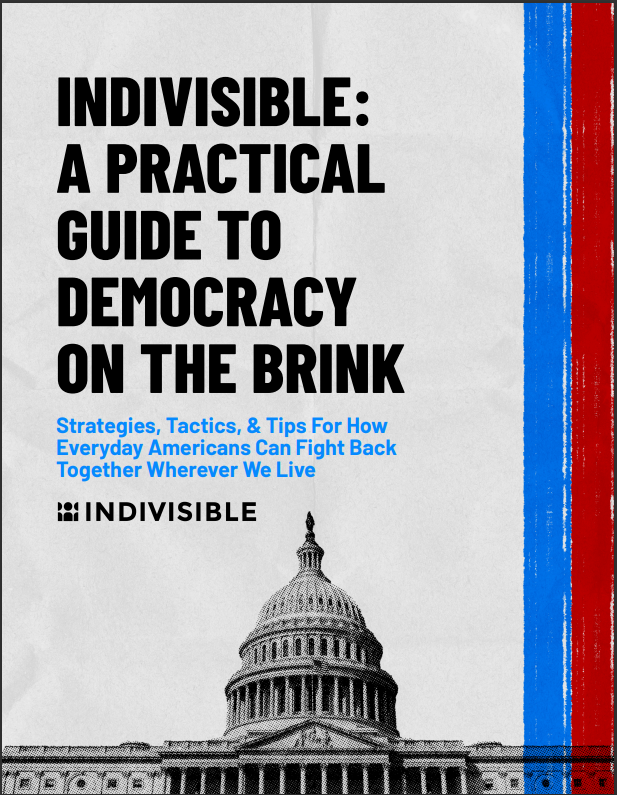
INDIVISIBLE: A PRACTICAL GUIDE TO DEMOCRACY ON THE BRINK
Strategies, Tactics, & Tips For How Everyday Americans Can Fight Back Together Wherever We Live
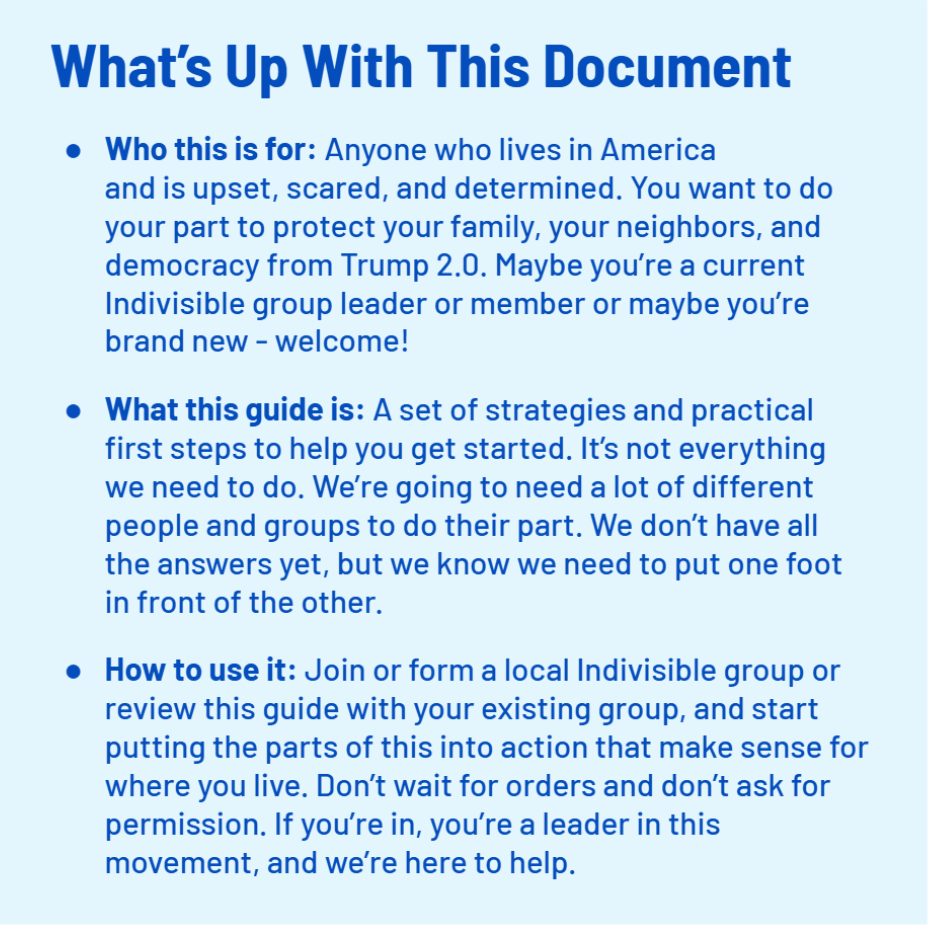
If there's one universally accepted truth in the modern age, it's that sequels suck. And Trump 2.0 will be no exception. Trump, Vance, and their MAGA minions feel vindicated by the victory of their bigoted, fascistic clown show of a presidential campaign. Trump takes office with a plan to institute the worst parts of Project 2025. He’ll be enabled by a judiciary packed with right-wing ideologues and a congressional majority stacked with MAGA foot soldiers. And he’s assembled a bloc of corporations and billionaires eager to do his bidding in exchange for tax cuts and corrupt favors. But he has no mandate for the staggeringly harmful agenda he’s about to unleash on the country. And together, we have the power to fight back — and win.
Democracy is in grave peril, but it is not dead. Fascists depend on convincing us to give our power away and fall in line, that the fight is over and we lost. And while we must be clear-eyed about the threat, we must not do the fascists’ work for them by giving them powers they do not have. Trump wants to govern as a dictator, but he has the slimmest possible congressional majority and a grossly unpopular agenda. Winning an election with 49.9% of the vote (of those who voted) does not make him a Dictator for Life and does not make Project 2025 the law of the land.
The truth is that political power resides in many places — from local to state to federal. To stave off the fascists, we must tap into that power in every corner of our country. We must organize ourselves to block their attacks, break MAGA’s political strength, and build a winning majority coalition of our own. Leadership in this moment must come from regular people, not just politicians. Elected Democrats will need our encouragement, support, and cajoling to find their spines and fight back. Elected Republicans can and must break with MAGA or be held accountable for the harm they cause. This guide outlines concrete strategies and tactics that collectively will help us limit harm, win in 2026, and throw MAGA out in 2028.
Eight years ago, we wrote the Indivisible Guide to organizing locally to pressure Congress and block the Trump agenda. Now, we’re offering our best advice on how everyday people can organize to stop Trump 2.0. There’s a lot we don’t know about what needs to be done. We’ll need to learn and experiment as we go. But we hope that this guide will be useful for people across the country who are grappling with what they can do in this moment.
Our shared future depends on everyday Americans choosing to fight back. We believe each of us has a role to play — in blue states, red states, and political battlegrounds across America. We believe MAGA will seek to divide and conquer us, isolating us one by one in an attempt to fracture our resolve. We believe standing together, Indivisible, is the only way to protect our families, our neighbors, and our democracy. And we believe that we will win.

One-Page Summary
Chapter 1: What Happened and Why it Matters. Heading into the 2024 election, Americans were angry about inflation and frustrated with the status quo. Some voters either flipped to Trump or didn’t vote at all. That gave Trump the margins to win — but it doesn’t give him a mandate for dictatorship or Project 2025. Americans of all stripes are going to be pissed when Trump 2.0 comes to town dressed in chaos, corruption, and cruelty. We can stoke that backlash to break up their coalition and build ours.
Chapter 2: A Quick Primer on Constituent Power. Trump wants us to believe that the presidency is all-powerful. It ain’t true. Political power in our democracy overlaps between local, state, and federal electeds. Your power comes from your ability to be a source of support (or a pain in the ass) to those electeds. You can use this power to get them to stand up to Trump 2.0 or face political consequences. We review the basics of constituent power — what it is, how it works, and how yours can do the most good in this moment where you live.
Chapter 3: The Plan to Get Through the Next 2 Years. Our best chance to get through this era with some amount of democracy intact is to hang on until 2026 and win big in the midterms — breaking Trump’s hold on Congress and making sure election deniers and saboteurs aren’t in charge of the 2028 election. We’ve boiled it down to three big plays:
- We will all throw in to say NO to the Project 2025 agenda pushed by the White House and Congress. We’ll stop what we can and pick strategic fights to drive national backlash to win in 2026.
- We will play hardball wherever we’ve got Democrats in local, city, or state office — pushing them to block, delay, and challenge MAGA’s attacks.
- We will work to protect and win elections — defending against election deniers in swing states and turning all that national backlash into an electoral majority coalition that delivers big wins in 2026.
You’ll plug into the plays that make the most sense for where you live and the leverage you have. Think of it as a giant national pro-democracy team — some of us are playing offense, some are playing defense, but if we all play our roles, we’ll make it through together.
Chapter 4: Protect and Prepare. Things are about to get much worse, and we need to treat an attack on one as an attack on all of us. That means supporting communities under threat and preparing to operate under increasingly authoritarian conditions. We’ll review how to:
- Organize to Protect Communities Under Threat. MAGA will hit hard, and we’ll need to stand together.
- Operate Under Authoritarian Creep. We’re not giving up on democracy, but we are not naive about what we face. We’ll cover lessons learned about operating under increasingly authoritarian conditions.
Chapter 5: Practical steps for finding or forming your local Indivisible group. Fascists depend on you, believing you’re alone and powerless. And honestly, on your own, you don’t have a ton of power. But, organized groups of individuals do have power. If you’re a fan of an existing group in your area, join it. If not, get a few friends together, start a new local Indivisible group, and build from there. Your local group is the basis for everything else you can hope to achieve in this period. This chapter includes some starter recommendations for how to pull your new, local, volunteer-led Indivisible group together, connect with others on the ground, and get to work.
Chapter 1: What Happened and Why It Matters
“Oh my *bleeping* God.” — All of us
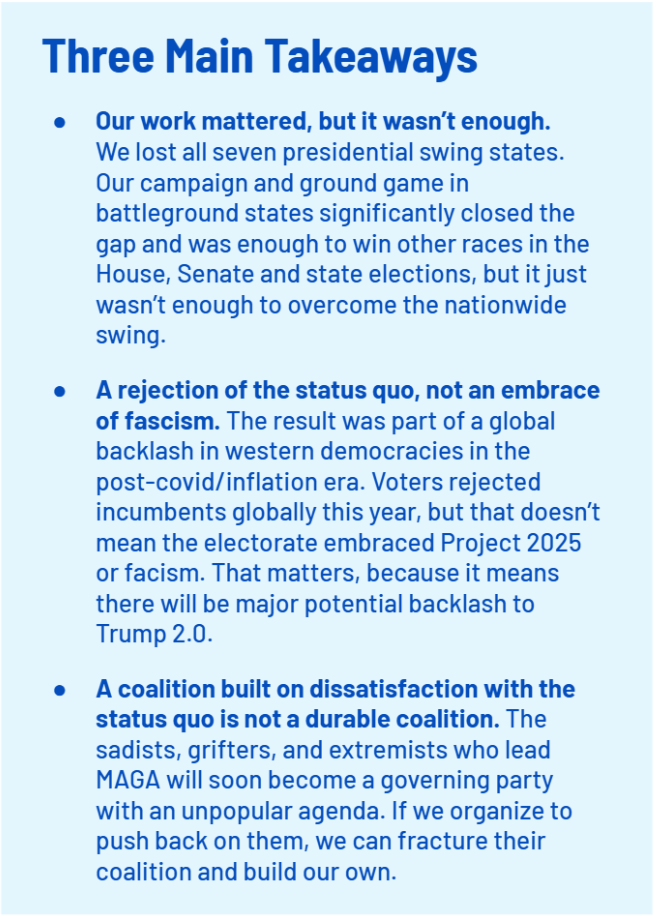
We lost an election that many, including us, thought was the most important election of our lives. Like so many across the country, we were overjoyed to elect the first Black woman President and move forward on her agenda. Now, we face not only the profound disappointment and sorrow of having that hope snatched away — we also face a resurgent American fascist movement on the verge of claiming power.
Trump will now take office with a slim but real congressional majority. He has a packed, rightwing Supreme Court that has already ruled that a president can act with impunity as long as his actions are done under the guise of official business. In addition to a truly abhorrent social and economic policy agenda, Trump has promised an administration of retribution and to be a dictator “on day one.”
Does losing this election mean the American experiment with representative democracy is over? In this chapter, we’ll try to address this central question. Our argument is this: the doomsaying wasn’t wrong, but our democracy is not dead, at least not yet. We believe democracy in America may not survive the Trump era, and we believe that whether it survives depends on what we do next.
In the immediate aftermath of a loss, blame flies freely, and solid analysis is in short supply until full data is available. The process of developing and analyzing real data from a national election — especially digging into how different demographic groups voted — takes weeks or months. In the meantime, anyone with an ax to grind shows up to explain why their approach would have won. If you want that kind of analysis, you can get it in plenty of places. Instead, in this chapter, we’re going to try to focus on what we know happened and what it means. You should expect this analysis to sharpen and revise in time.
A nationwide swing against us. Of the seven presidential battleground states we competed in — AZ, NV, WI, MI, PA, NC, GA — we won none. We saw troubling losses in blue areas: our margins in New York, for example, were the worst since 1988, and other Democratic strongholds (CA, NJ, IL, DE) saw significant shifts away from Dems as well. The county map of shifts from 2020 to 2024 tells a depressing but clear story. With few exceptions, almost every one of the 3,144 counties in the country shifted against us in the presidential race.
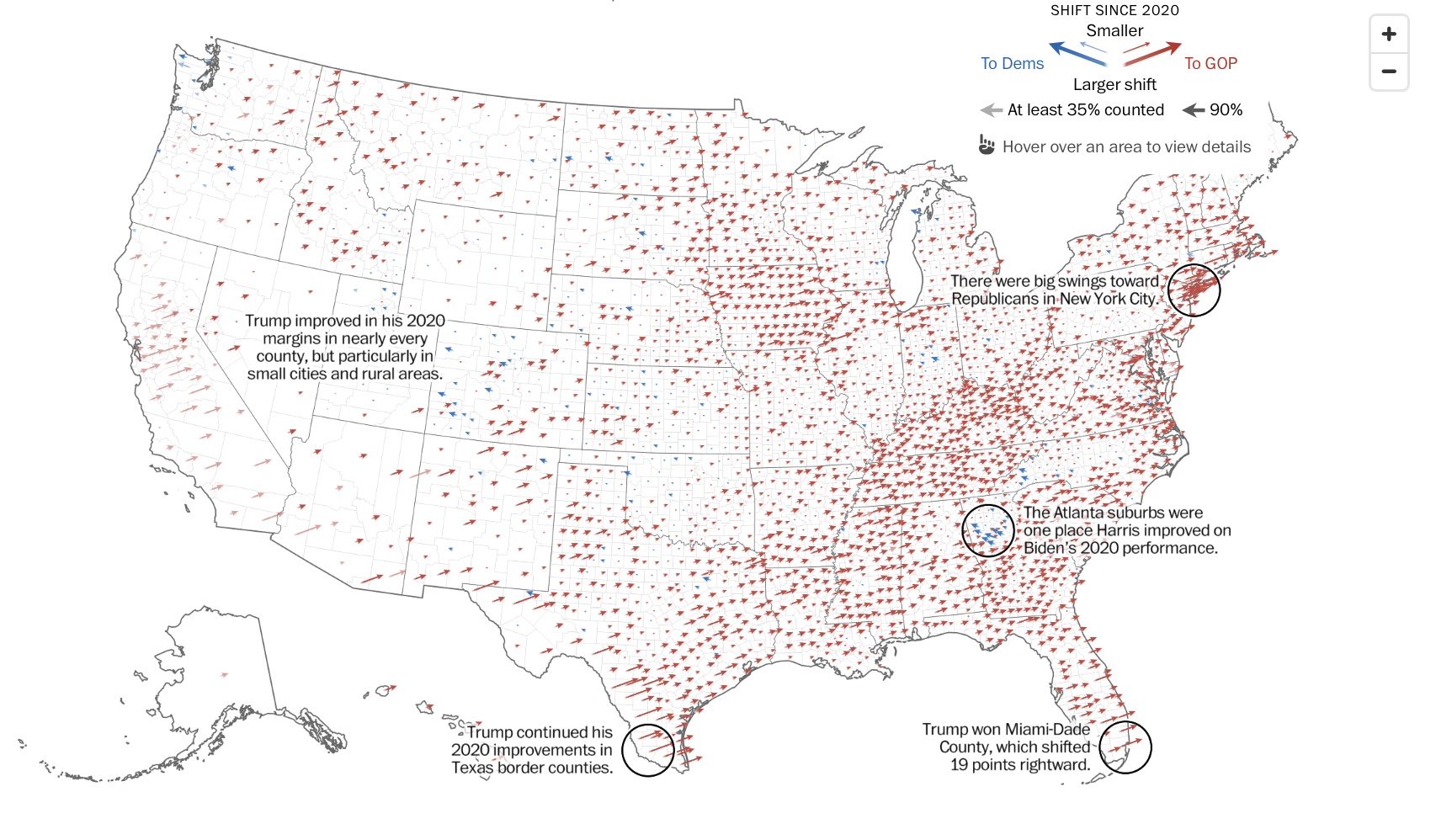
Between 2020-2024, the overwhelming majority of counties swung towards Trump. Source: Washington Post

Why the gap between battleground vs non-battleground matters. As you dig into the national data, one big takeaway emerges: the swing against us in the battleground states was significantly less than the swing against us in non-battleground states.
In other words, where we invested in an effective campaigning, ground game, and GOTV efforts, we closed the gap by as much as 5-6%. As you’ll see to the right, we were swimming against a powerful current. But that doesn’t mean the work we did on the ground to get out the vote didn’t matter. To take one obvious example: the ground game margin probably made the difference between victory and loss in the WI, AZ, NV, and MI Senate races and the NC statewide races — where we won.
A dramatic global backlash against incumbents. For the first time in the history of modern democracy stretching back to 1905 (as far as the data goes), every single democracy that held elections this year has seen a decline in vote share for the governing party. Ideology, policy agenda, and time in office didn’t matter. From France to Slovenia to South Korea, every ruling party lost vote share this year. In short, it has become clear that this year was a historically bad time to be a national governing party looking for votes.

In 2024, for the first time, the governing party in every country that held national elections lost power. Source: FT
Voters rejected the status quo — they didn’t embrace fascism. The best way to understand this is that voters were given a choice between the status quo and “not the status quo.” President Biden’s approval rating sat under 40% for this entire election season; by wide margins, Americans said the country was on the wrong track, and large majorities cited lingering and intense economic pain due to inflation and the aftermath of COVID. Vice President Harris ran an impressive campaign on an impossible timeline — but she couldn’t overcome the widespread frustration with the incumbent. The result was that a bunch of people chose “not the status quo,” either by voting for Trump or not voting at all.
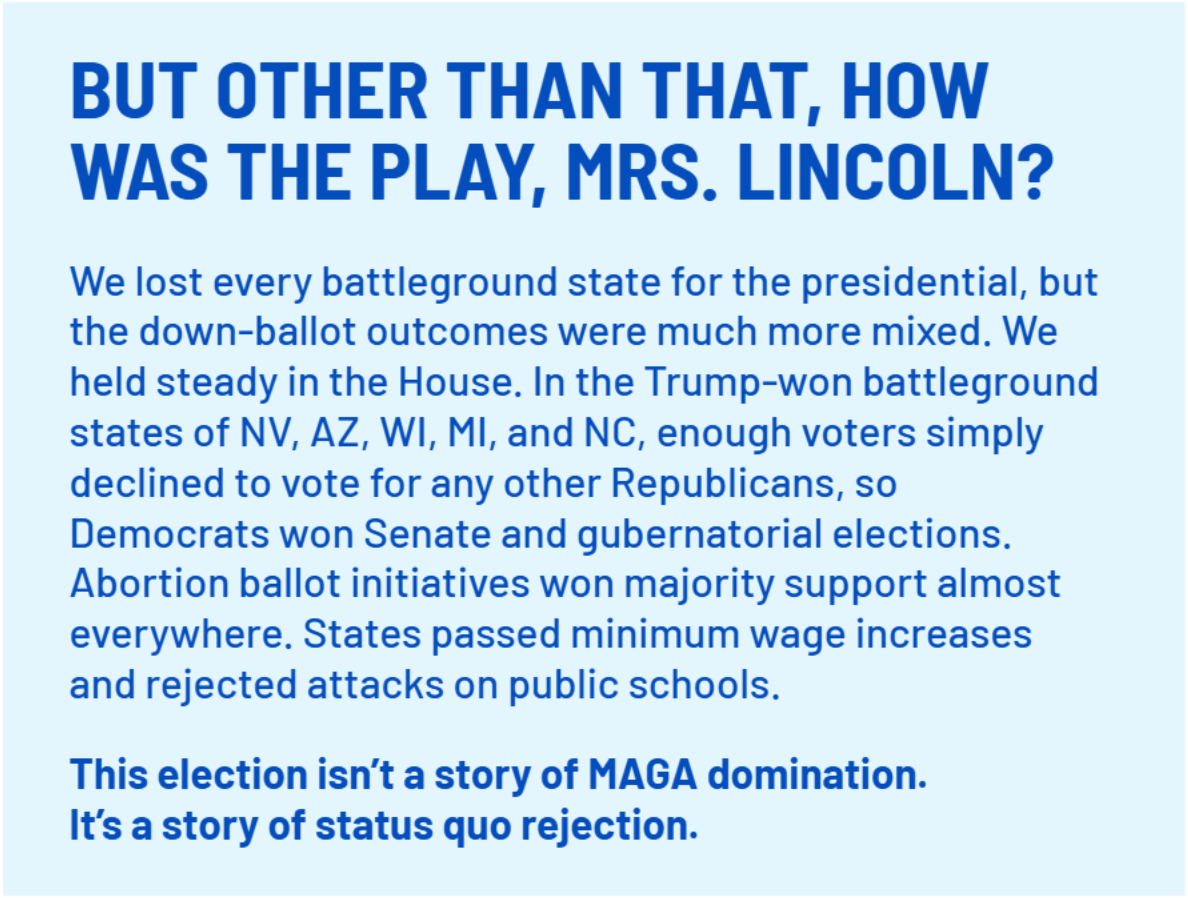
There’s longer-term stuff here that we need to explore and take seriously. We’ve known for a long time that a lot of people do not believe that our democracy is responsive to their needs or that the economy is working for them. We’ve seen a multi-cycle erosion of working-class support for Democrats and a broad trend towards anti-establishment distrust from voters who think the system is broken. We’re in a short-term fight with MAGA as a political force — but we have a much longer struggle to build the kind of political system that strengthens regular peoples’ trust in democracy because they experience it delivering for them.
We can have long debates about what that will take. But the painful 30,000-foot reality we see clearly in the results is that we simply were not able to convince enough people that the threat posed by Trump to democracy, to abortion, and to all our rights and freedoms outweighed their frustration with the status quo.
What this means for our next steps. Let's be real: Trump won a narrow victory in the swing states. It feels shattering because we hoped to see a national rejection; instead, he made gains. But this win is not a mandate, and it’s not a durable coalition. Sure, Trump has his die-hard MAGA base, animated by white grievance politics and Christian nationalism. But his win relied on peeling off people who are frustrated and alienated, not pro-fascist or pro-Project 2025, and on voters staying home.
The fact that Trump managed to turn himself into the change candidate is infuriating — but it also points to the path forward. Once he takes office, he sheds the mantle of “change” candidate and becomes the avatar of a corrupt and extremist administration. Trump won by literally putting as much distance between himself and Project 2025 — i.e., his policy agenda — as he possibly could. That is not a separation he can maintain once in office, once his team starts putting his agenda into action. Our work defining Trump 2.0 and its apologists by their worst and most devastating policies begins now.
This doesn’t happen automatically, and it won’t happen without all of us. But it’s possible to prevent some of the harm that is coming to our communities while building to break the MAGAs back in the midterms. That brings us to what is in our power to do in the next chapter.
Chapter 2: A Quick Primer on Constituent Power
“There go the people. I must follow them, for I am their leader.” — Alexandre Auguste Ledru-Rollin

We still live in a federated representative democracy, imperiled as it is. It has several layers. We have a national republic composed of 50 states where 19,000 cities, towns, villages, and more unincorporated areas are home to about 335 million Americans who vote for hundreds of thousands of electeds spread across all levels of government. Every drop of political power running through that cascade of governance flows from one single source: the people. That might sound like schlocky inspirational PBS after-school pablum, but at least for now, it is literally true.
This chapter builds on the lessons from the original Indivisible Guide and extends them based on what we’ve learned since, offering some practical advice on how to take advantage of the opportunities in your own geography to do your part in this fight.
“Constituent power” in an imperiled democracy. Why is a road paved or an education bill blocked or a state of emergency declared? Who gives electeds the right to do that? We do — it’s our power that we lend them for a time. Then we reclaim that power and consider who to give it to next — we call that an election. In between elections, we make the threat of retracting or the promise of reinvesting that power — we call that accountability. We organize to help them achieve our goals, or we organize to be an enormous pain in their ass if we don’t like what they’re doing. Taken together, and you have what we call “constituent power."
We all know this is not a well-functioning representative democracy for us constituents. An election-denying convicted felon who launched a bloody insurrection just escaped all legal consequences and retook the presidency. Many electeds simply will not give a damn about your constituent power over the next two years — they’re too safe in their gerrymandered districts and too aligned with MAGA. On top of this, Trump is promising to use vast powers to limit our ability to fight back.
Against all this, it’s tempting to conclude: game over, we lost.
But here’s the first rule of fighting fascists: don’t give up your power, and don’t give them power they don’t have. The mechanisms of our elections and responsiveness to our advocacy have weakened since Trump first won office. But they still exist. We have the choice of giving our constituent power away or using it in defense of families, communities, and democracy. We choose to use it.

What is your elected thinking about? Reelection, reelection, reelection. As former congressional staffers, we wrote the original Indivisible Guide after Trump first won in 2016 to demystify how Congress works so that normal folks organizing in their own communities could better apply pressure to fight Trump’s agenda. We wanted folks to effectively rally behind Democratic allies, help mushy Democrats find their spines, and weaken the resolve of congressional Republicans who might ally with Trump.
We built that guide around Congress, but the basic lessons apply to how all electeds think. It works like this: your electeds care first and foremost about getting reelected and growing their own power. Some of the good ones care about doing good, and some of the bad ones care about doing bad, but regardless, they all know they can’t do anything unless they grow or maintain their base of support to win reelection or win higher office.
Despite recent events, that basic idea still holds. Electeds still care most about people in their districts, organized groups of people have more power than individuals and constituent advocacy can — in many cases — still shift how your elected officials behave.
To win reelection, an elected official must prove to their constituents that they’re one of the good ones, despite how much everyone hates Congress, the state government, or city hall. That means a successful elected spends an inordinate amount of time and effort trying to generate this outcome on their home turf:
“My elected cares about me, shares my values, and is working hard for me.”
— What every elected wants their constituents to think.
It’s that basic insight that gives an organized group of constituents — like your local Indivisible groups — power. If you organize locally, focus on your own electeds, and make enough of a public ruckus that endangers their local reputation as an upstanding elected, you can shift their behavior and/or soften them up for reelection. You just need to know what they care about to influence their behavior.
What Your Elected Cares About
When it comes to constituent interactions, electeds care about what makes them look good, responsive, and hardworking to the people of their district. In practice, that means they care a lot about some things and very little about others. Organize your time and effort accordingly.
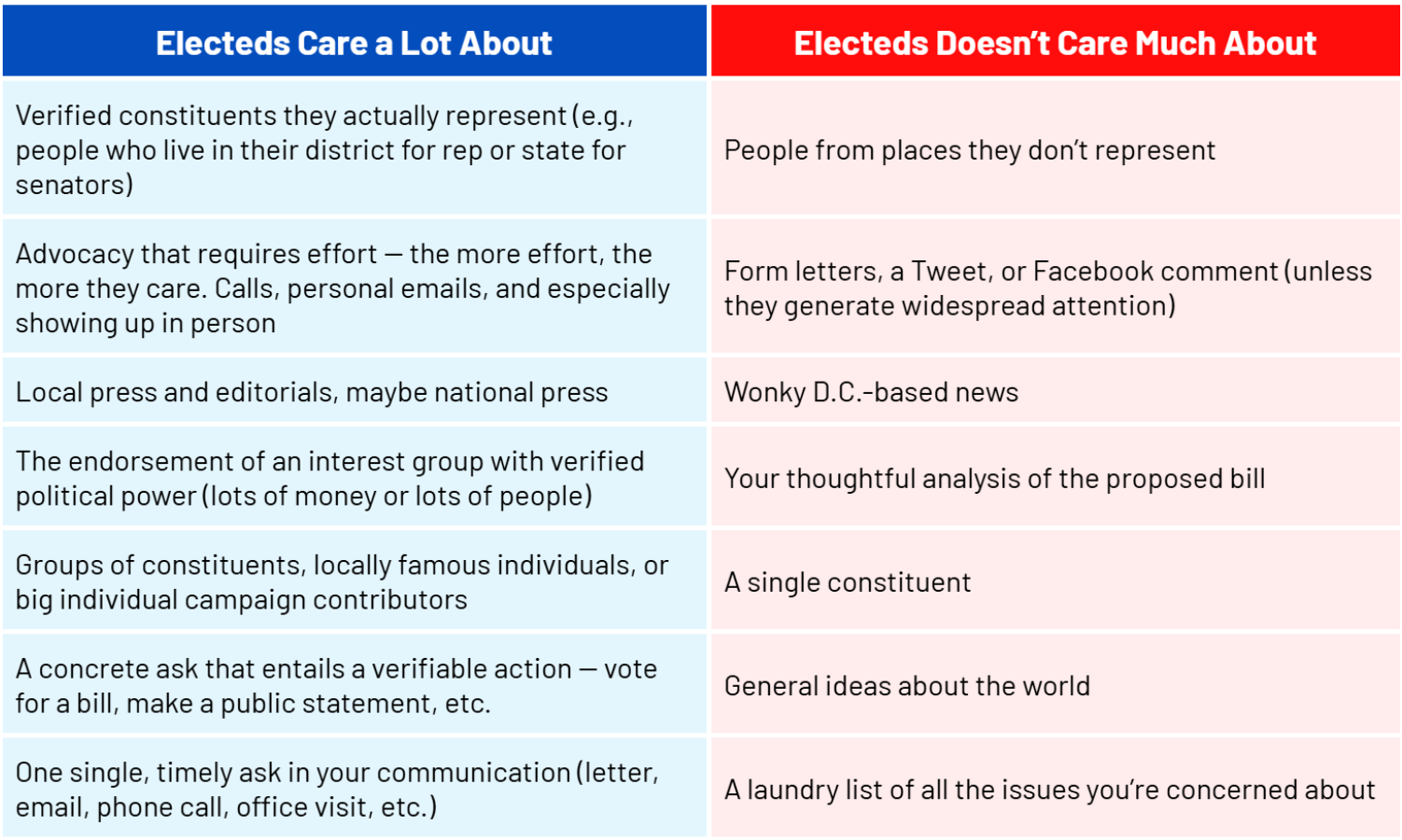
What Your Elected Considers a Good Outcome vs Bad Outcome
To make this a bit more concrete and show where advocacy comes in, below are some examples of actions that an elected might take, what they’re hoping to see happen as a result, and what they really don’t want to see happen. Some electeds will go to great lengths to avoid bad outcomes — even as far as changing their positions or public statements.

This time is different, and we must adjust our strategies. After Trump’s first election, this basic strategy worked. We used it to save the Affordable Care Act in 2017 and build the largest midterm margins in the history of the republic to take back the House in 2018. But while some of the original Indivisible Guide is applicable, not all of it is, and we’ll have to evolve it for the present moment. Here are some key lessons we think we should carry forward, as well as others that need to be updated and evolved.
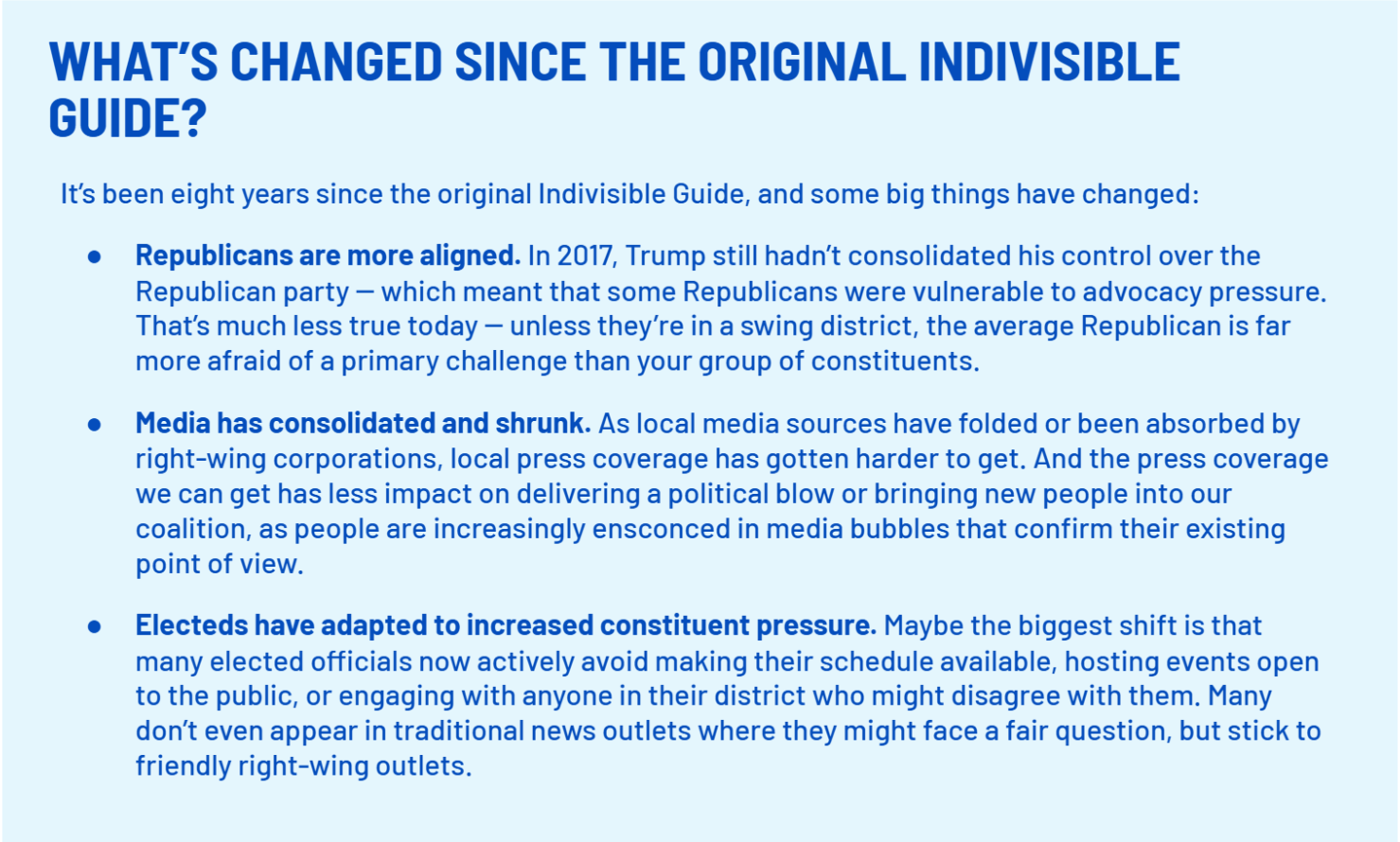
Focus your energy where your constituent power actually works. While some key applications of constituent power will look the same regardless of where you live, others will depend on your own personal local and state political landscape. Maybe you have a MAGA representative but a pro-democracy governor. Or maybe you’re in a blue dot in a red state. Or maybe you have Democrats all the way from city council to senator. The next chapter goes into how a winning strategy can stop some of Trump 2.0, limit harm, and build a majority coalition to break MAGA’s back in the 2026 midterms.
Chapter 3: The Plan to Get Through the Next Two Years
“Hope is not the absence of despair — it is the ability to come back to our purpose, again and again.”
— Alicia Garza

Over the next two years, staving off the fascists will require each of us to tap into our constituent power and identify where it can work. We’ll target Congress and our key state and local levers of power. We’ll try to block as much as we can. Where we can’t block, we’ll use what’s happening to break up Trump’s coalition and build ours. It will require playing defense in some places and going on offense in others. Think of it as a giant nationwide pro-democracy team, with each of us playing a specific position on the field.
Why are the 2026 midterms so crucial? If we win in 2026, we can achieve three things:
- Puncture Trump’s aura of omnipotence. A big, resounding backlash to Trump 2.0 will dispel the (misguided) notion that he is all-powerful or has the consent of the governing public for his actions.
- Create federal checks on MAGA’s power. This will also be our chance to flip the House (and, less likely but not impossible, the Senate), blocking further legislation and giving us crucial oversight powers.
- Protect the democratic transfer of power in 2028. The winners of the 2026 swing state elections will administer the presidential election in 2028. If they are MAGA election deniers, we’re in very big trouble.
In short, the path to future democratic transitions of power runs through holding off harm now and building for a big win in 2026.
Three Big Plays
We’ve identified three big plays that we — regular people organizing locally around the country — collectively need to make to get to 2026:
- We all throw in to say NO to Project 2025 when it’s pushed by the White House and Congress. We’ll stop what we can, and we’ll pick strategic fights to drive national backlash to win in 2026.
- We play hardball wherever we’ve got Democrats in local, city, or state office — supporting and/or pushing them to block, delay, and challenge MAGA’s attacks.
- We work to protect and win elections — defending against election deniers in swing states and turning all that national backlash into an electoral majority coalition that delivers big wins in 2026.
These plays do not include everything that everyone has to do over the next two years. They’re our best attempt to summarize what you, a regular person, can organize locally to do right now to make it through.
Let’s take them in order.
Play # 1: We All Say No To Project 2025
We have to be real: for the next two years, a Republican White House and Congress will have the power to set the federal agenda, but they do not have the power to impose that agenda on the rest of us unilaterally. Trump’s team will start trying to move parts of Project 2025 on day one. They’ll unleash a barrage of dangerous executive orders, appoint vile Cabinet nominees, and ask Congress to move swiftly on legislation to advance their priorities. How much of it they complete depends on Congress, the (heavily compromised) courts, and public opinion. That’s where we come in.
Once Trump enters office, we’re going to pick some national battles — places where we can land a win that stops harm, where the fate of democratic institutions is at stake, or where we think that fighting back helps to energize our coalition and fracture theirs politically. That might be a fight to stop Congress from gutting our healthcare or passing a trillion-dollar tax giveaway to billionaires. It might be a political prosecution of a Trump enemy. It might be a fight that we don’t even know is happening yet. But we should be prepared for them to start fast — literally within the first few days of taking office.
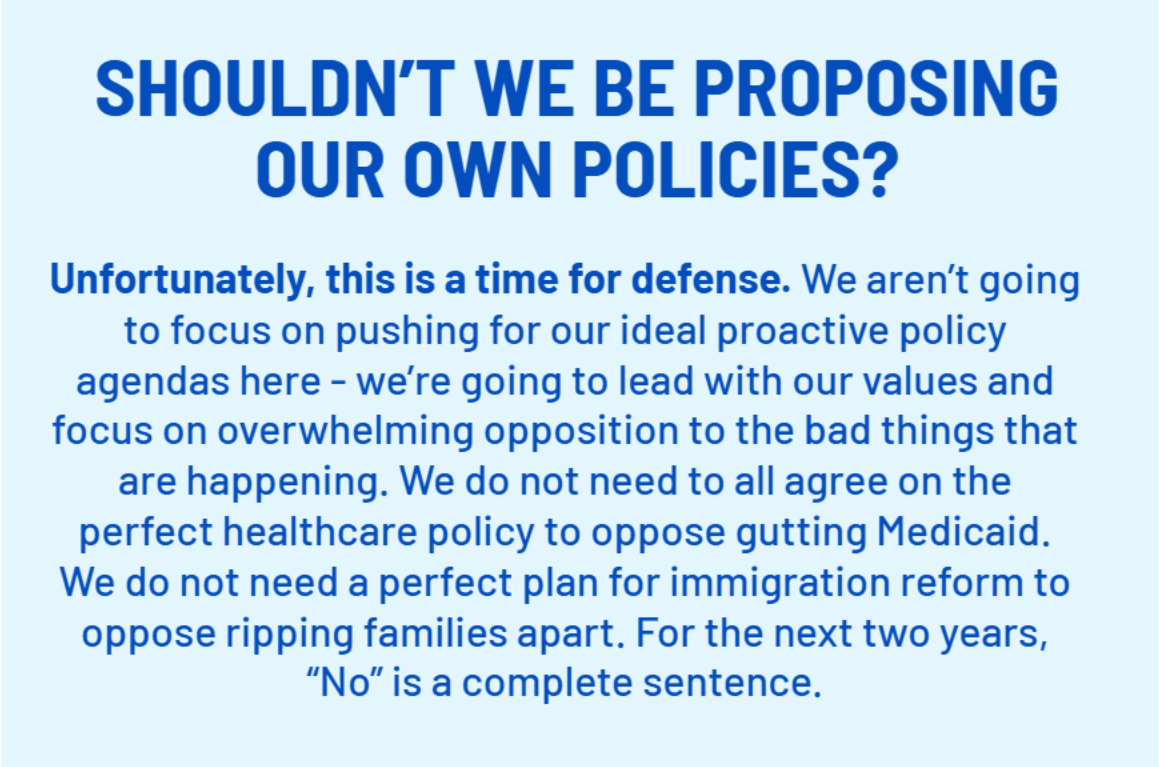
What are we going to do? We’ll fight to win, to delay, or to land a political blow. We’ll push Democrats to stand in lockstep opposition, hold Republicans accountable every step of the way for unpopular actions, and tell the story of what’s happening — with a focus on the tangible ways it’s causing harm to regular people. Together, we’ll show that it’s possible to fight Trump to a draw and sometimes score a win — and in doing so, we’ll set the stage for 2026.
What can we achieve if we do this?
- Delay, distract, and limit attacks. The Trump administration has a limited number of people, a limited number of hours in the day, and a limited number of legislative days for Congress. Every hour of delay is an hour that they’re not moving on to their next horrible agenda item.
- Win (sometimes). Trump has an extremely narrow majority in the House — far smaller than his 2017 majority — and a 53-47 Senate is still very tight. If Democrats are united in opposition, he’ll need to hold his entire caucus to pass any legislation at all. And while the Trump administration rarely backed down in response to public pressure, they did occasionally. We won’t be able to stop all or even most of what he tries — but we can stop some of it.
- National backlash builds. Trump’s agenda is chock-full of policies that will cause direct harm to regular Americans — but that doesn’t mean they’ll hear about it or know who’s to blame. From the very beginning, organized political opposition is how we tell the story of what’s happening, fracture Trump’s unstable coalition, and build ours.
This play applies to you if:
YOU’VE GOT A DEMOCRATIC REPRESENTATIVE/SENATOR
Democrats are a skittish bunch, and there’s nothing like losing an election to plunge them into an extended depression that somehow ends with everyone forming reading groups to discuss Hillbilly Elegy.Your job is to interrupt this cycle as quickly as possible, and push them back into fighting form.
Maintaining lockstep opposition to Trump will be crucial — any Democratic support at all will give him cover to portray his gruesome policies as “bipartisan.” Remember, it was lockstep Democratic opposition to the MAGA agenda — including attempts to repeal the Affordable Care Act — in 2017 that defeated some bills and built the narratives that helped a Blue Wave retake the House in 2018.
That means your job is to support, cheerlead, or berate your Democratic Representative and/or Senators to be active fighters for every battle we fight on the Trump agenda. That work should be loud and public — whether positive or negative. We deserve champions in Washington who don’t just refuse to go along, but actively, passionately make the case against Project 2025 — let your representatives know you expect it of them.
YOU’VE GOT A VULNERABLE REPUBLICAN REP OR SENATOR UP FOR REELECTION IN 2026
Your representative would very much like to be excluded from this narrative. Their job depends on not being associated with the worst of Project 2025. They’ll try their best to keep their head down and stay out of the story. Your job is to make sure they can’t do that.

Demand your swing representative and/or senators show up in public. Make them explain where they stand at this moment of great divide. And make clear to them, and the broader community they represent, that folks paying attention in their district/state disagree with the MAGA agenda and want to see them vote against it.
Remember: your swing state representative and senators who are up for reelection in 2026 are primarily focused on their own political survival. They don’t want to be seen as too out-of-step with their district. They are worried about a Republican primary challenge if they break with MAGA, but you must also make them worried about a general election defeat. Building vocal, public, majoritarian opposition to Trump 2.0 and the MAGA agenda in their district or state can indeed shift their votes or, if necessary, soften them up for defeat in 2026.
YOU’VE GOT A SAFE REPUBLICAN REPRESENTATIVE / SENATOR
In the short term, in the next two years, there is little you can do here if your representatives and senators are in safe seats. This wasn’t always true — in 2017, Republicans of various stripes were sometimes reluctant to line up behind Trump’s agenda. But in 2024, Trump-skeptics have been booted out and replaced with true believers or cynical sycophants. These days, Republicans in safe districts will mostly ignore pressure from outside their base. Your job is to tell the story in your own community — recognizing you aren’t likely to shift their vote in the short term.
Play #2: Get Dems To Play Hardball In Local, City, And State Offices
We often hear from people in blue states lamenting how their elections are safely blue, and they don’t know how to make a difference. We have good news and bad news about that.
Blue state, city, and local organizing is incredibly urgent in this moment. Blue areas have enormous power to shape the terms of the national debate, to leverage their economic and political power to protect the things we care about, and to pick fights that help us highlight the rotten core of Project 2025. And you have a crucial role in ensuring they do it.

Democratic state trifectas following the 2024 election — states with both a Dem governor and state legislature.
Where Dems can go on offense and fight back, they should. Over the next two years, your Democratic elected officials will make choices every single day about whether to stand up to MAGA or whether to go along with it. Your spirited, determined advocacy will ensure that the good ones know they’ve got a movement behind them as they fight back — and the bad ones know they’re on notice.
Consider this: there are 15 states with a blue trifecta (a democratic governor and state legislature) — California, Colorado, Connecticut, Delaware, Hawaii, Illinois, Maine, Maryland, Massachusetts, New Jersey, New Mexico, New York, Oregon, Rhode Island, and Washington. That is nine more trifectas than we had in 2017. These 15 states represent nearly half of the national gross domestic product and have an outsized level of cultural and economic power. If you live in one of those states, you need to be asking: what is your state doing to leverage that power to stop MAGA’s abuses and harms? Even if you don’t have a unified Democratic government, your governor or AG still has quite a lot of independent authority — or you might have levers at the city, county, or town level.
That’s a lot of power, and it’s time to ask them exactly what they’re doing with it. Are your Democratic electeds passing legislation to protect you, your neighbors, and red staters seeking safety? Are they pushing back against MAGA efforts to target your neighbors? Are they working with other Democrats to create alliances and compacts? Are they using their economic leverage to advance our values? How will they protect labor, civil rights, and environmental standards? Are they using the full power of their office, at every level, to block and delay the MAGA agenda? How will they respond when Trump and Stephen Miller escalate their campaign of terror?
There’s enormous potential here — we just need to organize to tap into it.
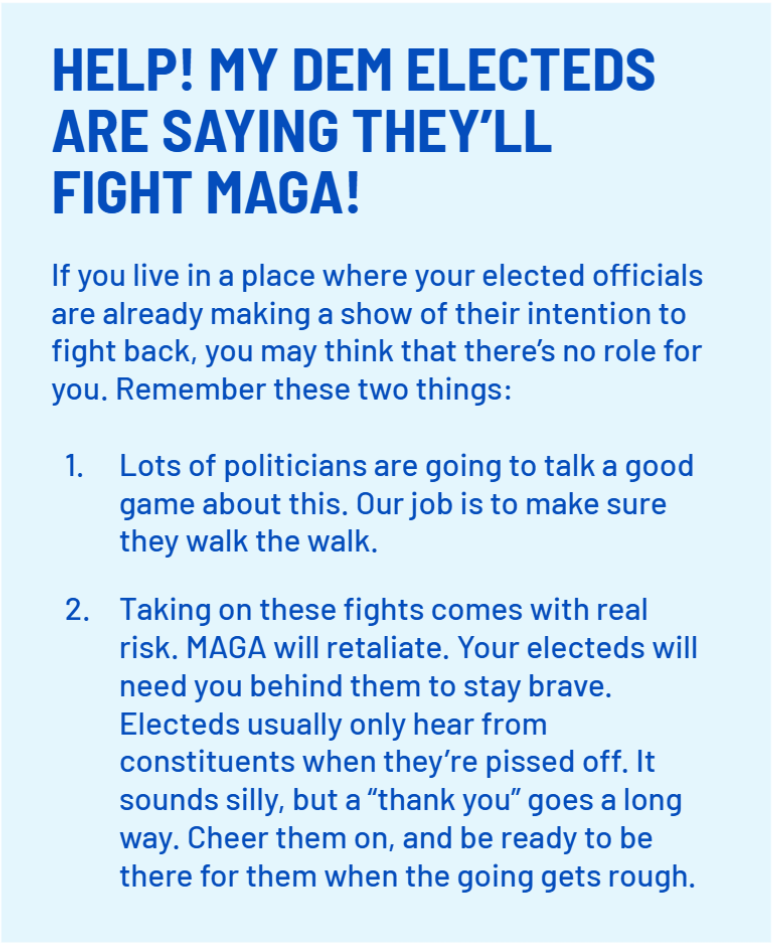
What can we achieve if we do this?
- Block, delay, or distract the Trump administration.Trump’s people have the same number of hours in the day as the rest of us. Widespread efforts to throw sand in the gears of their attacks — from lawsuits to legislation to strategic acts of defiance — will make it harder for them to roll out their full agenda.
- Protect people, policies, and progress. From inter-state compacts to maintain policy standards to actions by governors to protect immigrant families from deportation, energized, visionary governance can do a massive amount of real good.
- Mitigate harm for red staters. Whether they voted with us or not, people who live in red states deserve better than what they’re getting. Policies that help them — and highlight the gap between red and blue states — are good substantively and politically.
- Present an alternate story of life under Democratic governance. Making people’s lives in blue states better — more affordable, safer, and fairer — is good on the merits and part of how we strengthen the Democratic brand for the future.
This play applies to you if:
YOU’VE GOT A DEMOCRATIC GOVERNOR, ATTORNEY GENERAL, OR LEGISLATURE
Democratic state leadership and legislatures have significant power to counter Trump’s agenda directly and protect residents within the state. Here’s a (non-exclusive, sure to grow) list of some steps you can encourage them to take:
- Sign Executive Orders to Protect Residents:Democratic governors can issue orders that directly counter federal actions, like establishing protections for immigrants, expanding access to reproductive healthcare, or enforcing strict environmental standards that defy federal rollbacks.
- Form Alliances with Other States: Urge your governor and AG to join regional compacts on issues like climate change, data privacy, and healthcare. These alliances strengthen state policies and create a unified front that makes it harder for Trump’s administration to dismantle progressive gains.
- Use their Economic Leverage:States with significant economic power, like California and New York, can use their influence to counter Trump’s agenda by setting procurement and contracting standards that prioritize civil rights, environmental responsibility, and fair labor practices. Blue states can refuse to do business with companies that don’t uphold progressive values, using their economic might to challenge Trump’s policies.
Decline to implement federal policies in their states: Atonof federal programs or legislation is actually dependent on the states implementing them. Your governor could decline a pot of money earmarked for a police crackdown on peaceful protests or refuse to participate in a program that would require granting massive loopholes to giant corporate polluters. If there’s an opt-out, they should be taking it.- Implement Sanctuary Policies for Out-of-State Visitors:Blue states can enact laws that protect individuals traveling from red states to access services restricted under Trump’s policies. For example, protections for reproductive healthcare or gender-affirming care reinforce blue states as safe havens for civil rights, creating a direct challenge to Trump’s efforts to impose regressive values nationwide.
- Create Legal Funds to Protect Residents:Democratic states can set up state-funded legal defense funds to help residents directly affected by Trump’s policies, such as immigrants at risk of deportation or families losing healthcare. These funds signal that the state is ready to stand up for its people, regardless of federal threats.
- Implement policies that make their state a thriving, healthy, and desirable place to live:It sounds simple, but the more that Democratically controlled areas deliver a high quality of life for their residents, the better we’re able to make the case against the MAGA agenda to the American people.
By actively pushing your state government to take these steps, you can help build a network of resistance that not only defends state rights but also pressures Trump’s administration to back down on the worst elements of its agenda.
YOU’VE GOT A DEMOCRATIC CITY GOVERNMENT
If your city government is controlled by Democrats, you have the opportunity to work with local leaders to resist Trump’s agenda on a more granular level. While city governments don’t have the same powers as states, they still play a vital role in protecting residents and sending a message that MAGA policies won’t go unchallenged. Here are some ideas on what you can push them to do:
- Adopt Sanctuary Policies: Many cities have already become sanctuary cities, refusing to cooperate with federal immigration enforcement. If your city hasn’t done so, advocate for this policy to protect immigrant residents. Sanctuary cities make it harder for Trump’s administration to carry out large-scale deportations, especially when states and cities work together.
- Expand Protections for Vulnerable Communities: Local governments can pass ordinances that protect housing rights, fund community health programs, and ensure that LGBTQ+ residents feel safe and supported. These policies create safer spaces for residents and demonstrate what pro-democracy governance looks like.
- Invest in Local Environmental Initiatives:Cities can enact local climate policies like banning single-use plastics, promoting renewable energy, or creating green infrastructure projects. These actions contribute to national environmental progress and create visible, tangible benefits for residents.
- Partner with State and Regional Allies: Encourage your city leaders to work with state and regional governments on issues like transportation, affordable housing, and voting rights. This collaboration strengthens progressive policies across jurisdictions and shows that cities are part of a larger resistance against Trump’s agenda.
- Create policies that make their city a thriving, healthy, and desirable place to live:The more that Democratically-controlled areas deliver for their residents, the better we can make the case against the MAGA agenda to the American people.
By mobilizing locally, you can help ensure that your city government defends its residents and becomes a model of progressive governance that opposes MAGA’s harmful policies.
Play #3: We Work to Protect and Win Elections
The future of our democracy depends on our ability to have elections in 2026 and then win those elections in 2026. That’s for a straightforward reason: the people who win that year will be the people who are in charge of administering the 2028 election. If MAGA fanatics or election deniers win key roles in swing states and swing districts, we’re in very deep trouble.
The path to reclaiming power at the federal level also runs through swing districts and states. Taking back the House (and — more formidably — the Senate) would block Trump’s ability to pass any more legislation, give us negotiating power as a partner in must-pass legislation like budgets, and give Democrats investigatory and subpoena power. None of this works on its own to check a would-be autocrat — but it’s more tools in the toolbox.
What can we achieve if we do this?
- 2026 elections are held under conditions we can win. We won’t be able to stop every election denier in a county clerk’s office from pulling some shenanigans. Still, dedicated local organizing can make sure as much of the 2026 election takes place as freely and fairly as possible.
- State-based and federal pressure softens our targets in advance of the election. For the next two years, your Republican state officials and federal officials need to answer for every single action the Trump administration takes that hurts your state and its people.
- We WIN the key state and local offices. We need to win Governorships, Secretaries of State, state legislature seats, House races, and local elections offices to safeguard national elections in 2028. Doing this doesn’t guarantee a democratic transition in 2028, but it is an absolutely necessary precondition.
This play applies to you if:
YOU’RE IN A SWING STATE
Every single swing state has crucial statewide or federal seats up for election in 2026. The question is: what activities in 2025 will best set you up to win next year?
This is a choose-your-own-adventure situation. If you’ve got a Republican Senator up for reelection — looking at you, North Carolina, Maine, Alaska — you might want to go all in on an advocacy and accountability campaign. If you’ve got a crucial Governor or Secretary of State race — hello, Arizona, Michigan, Georgia, and Wisconsin -- you may want to focus on campaigning for state legislative fights or preparing for the state elections.
Whatever you choose, ask yourself: is what I’m doing:
- Strengthening my future Democratic candidates?
- Weakening my future Republican opponents?
- Building my base of involved, active people who will stay involved next year?
YOU’RE IN A SWING STATE WITH AN ONGOING THREAT OF ELECTION SUBVERSION
Dedicated local organizing — tracking your elected officials like a hawk, publicizing their actions, and organizing to pressure them publicly — will be crucial to stopping the worst actors on the right from subverting the 2026 elections before we can even hold them.
Depending on what angle MAGA electeds choose to take, these fights may seem technical or bureaucratic, but we can’t afford to sit them out. You can start by finding out who runs your local board of elections, what their record is, and when they’re up for reelection. Then, check out this resource from our friends at Protect Democracy for an idea of what kinds of attacks to look out for. If you’re in an election denial hotspot, we’ll help you get connected locally to get organized.
Wrapping Up
This chapter was both too much and needed to be more comprehensive. We have identified a few big plays that need to happen. We can’t possibly capture the breadth of strategies and tactics that we’ll need over the coming years to be successful. Among other unsolved problems, we need plans to combat disinformation, to develop our own independent communications systems, and to take on the corporate billionaires that are enabling the fascists. The best way to expand or innovate on this guide is not to do it by yourself — it’s to get together with other people and start coming up with ideas. And in fact, the first step to implementing anything in this guide is to find or establish your own local group. The final chapter describes how to do that.
Chapter 4: Protecting People and Operating
Under Authoritarian Creep
“They want you to be alone. Nobody is going to fix this alone. That’s not how this works.”
- Timothy Snyder, historian of authoritarianism and author of On Tyranny
What would you call a country where the highest court shields a former president from facing legal justice for launching an attempted coup and exempts him from prosecutions in the future? Probably not a healthy, functional democracy. In the days and months to come, you’ll hear discussions of fascism, competitive authoritarianism, electoral authoritarianism, democratic backsliding, and more. Social media is full of commentators describing democracy as “over” or confidently stating that we’ll have no more elections.
Our take is simple: for now, there’s still an enormous amount of power available to us in the democratic process, and we need to get as many people as possible to use as much of it as possible. Telling people that we no longer live in a democracy does not help us with that -- it conditions people to accept the current state as immovable. There may come a day when we conclude the conditions have crossed the threshold into full-blown authoritarianism, and at that point, we’ll all need to shift our strategy. But first, we’re going to give this everything we’ve got.
No one is debating that we should expect the incoming administration to operate with an unprecedented degree of lawlessness and malevolence and to greenlight state and local actors to do the same. Things will get worse, and we will need to work together to protect each other.
This chapter will discuss two crucial topics that are core to Indivisible’s values:
- Organizing to stand, indivisibly, with communities under threat
- Fighting for democracy under increasing authoritarian creep
Organizing to Stand, Indivisibly, with Communities Under Threat
MAGA will launch immediate and devastating attacks on its favorite targets — immigrants, LGBTQ+ people, women, racial justice advocates, anti-war activists, communities of color, low-income people, and more. They’ll double down on their efforts to deprive us of our rights, from abortion bans to mass deportations. Their efforts will be amplified by equally dangerous local and state actors who no longer fear federal government oversight.
This will play out differently depending on your local and state context, but one thing is clear: we will have to keep each other safe. Organizing locally -- in partnership with and across communities under threat -- is often where we’ll make the greatest difference. Local community organizing efforts will play a crucial role in building the volunteer and local infrastructure for mutual aid and support for people under threat, from immigrants to women seeking abortions to people who have lost their health insurance.
This is going to look different in different places, but depending on where you are, it might include:
- Participating in mutual aid: This could be working with immigrant rights groups on deportation defense, raising money for, or volunteering with, local actors helping patients access abortions, or supporting your local teachers union in their fight against a new draconian education policy.
- Fighting back against dangerous state and/or local legislation. We can anticipate a spree of additional legislation in red states escalating attacks on targeted communities or taking advantage of new openings created by federal action. Local groups can play an essential role in raising awareness of such efforts, pushing back against their passage, and highlighting the harm they create if they successfully pass. Maybe this is defeating a state-level abortion ban, or maybe it’s organizing to fight back against local school board efforts to attack trans kids or eradicate DEI and civil rights history from schools.
- Story-telling. While you may not have much immediately accessible political power, you have tremendous storytelling power. Humans are driven by the stories they internalize. In order to create a successful backlash to Trump’s unpopular overreaches, we will need stories from the frontlines of MAGA-world. Think about the impact of Kate Cox’s story or those of the women who died because they couldn’t access abortion care. Stories are how we will re-engage folks who have checked out, how we’ll break up MAGA’s base, and how we’ll stay closely knitted to each other through the tough years ahead.
This is inherently general advice because we’ll need to customize our approaches to the threat, the people involved, and what you can do to help. But here are some general guidelines on how to get started:
- Get connected locally. It’s common for new advocates to show up with lots of passion and little knowledge on a topic. That’s OK, but it means you need to focus on plugging into existing work, where you can add value and strength to ongoing fights and deliver the kinds of support that are being asked for, rather than going rogue and doing your own thing. Build trust by asking what the needs are and meeting those needs.
- Focus on tangible ways to help. This is not about posting the right message on social media in solidarity. It’s about actual, material support for people who are facing material harm. Communities are under threat, and the organizations that serve them are about to face extraordinary challenges. They will need money, local organizing support, mutual aid, and volunteers who can show up to help and organize for their interests in a hundred different ways.
- Organize yourself so that you offer clear value. In moments of enormous danger and stress, local community organizations are often in triage mode. Organizing new volunteers who want to help can be a huge time burden. That’s why it’s crucial to organize yourself and your local Indivisible group, figure out what you can offer, and approach ready to help meet the needs they’ve identified.
Trump has promised to prosecute his political opponents, weaponize the justice system, and unleash hell on his preferred targets, from immigrants to people of color to racial justice advocates to Muslims to people with disabilities to trans kids. With Trump’s followers emboldened, we also expect a rise in antisemitism, white nationalism, and other dangerous ideologies, making the risk of political violence even more real.
It’s reasonable to fear the potential costs of political engagement right now — especially if you’re a member of one or more of the communities we know will be targeted or if you’re in an area with repressive local or state government. Part of the fascist playbook is trying to shut down the pro-democracy side’s activists, institutions, and bases of power (that’s us), either through official government action or the threat of it. We can anticipate similar threats to our allies, like organized labor and reproductive freedom, immigrant rights, and racial justice organizations.
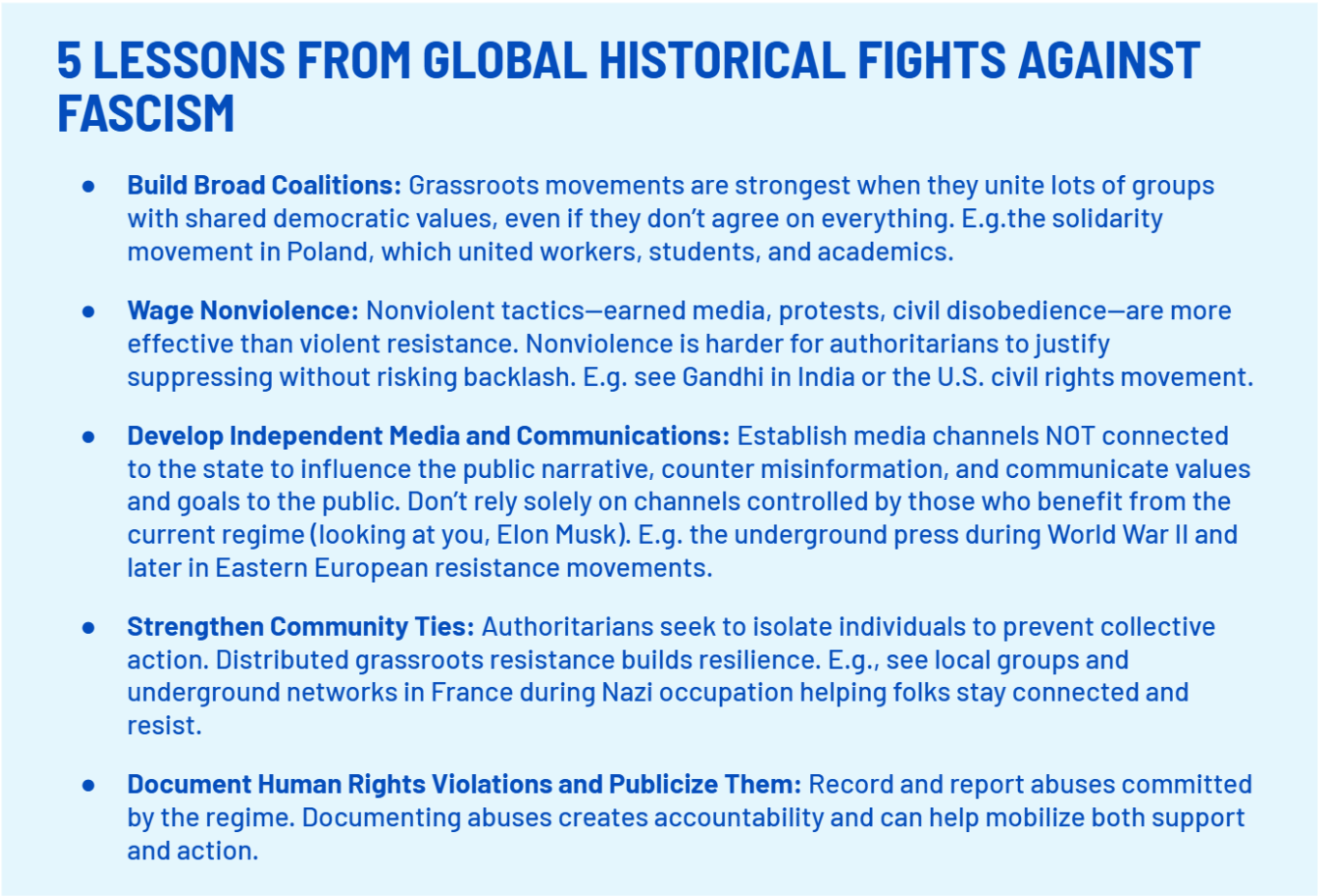
Safety, Security, and Digital Preparedness During Trump 2.0. We’ve assembled guidance on managing personal security and risk for Indivisible activists. There are absolutely steps you can take to mitigate risks — from event planning and physical safety during actions, to digital security and privacy on the internet and in your communications. These steps are wise to take and adjust to your personal context. However, we cannot promise that activism during this era can be done without risk.
The risk is real. But here’s the thing: it’s also a self-fulfilling prophecy. If we pull back out of fear of risk, the risk will increase as a smaller number of people become easy to isolate. Holding open space for dissent under a would-be fascist requires as many people in as many places as possible to organize and dissent in as many ways as possible. Solidarity with the first people targeted is a moral imperative, but it’s also a strategic one. It helps push back on future attacks on all of us. Widespread, broad-based opposition makes it harder for our adversaries to crack down and raises the costs of repression. And the absence of broad opposition makes it easier to throw the book at the few who dissent.
There is no easy answer here, and you will have to determine the level of risk you are willing to accept based on your own personal circumstances. But we will not get out of this mess without many, many people choosing to accept at least some risk.
One thing is clear: whether to protect each other and our communities, to bolster our democratic institutions, or to implement the strategies to build toward a win in 2026, the first step is finding or starting your own local volunteer group to get organized. We cover practical next steps for getting started in the final chapter.
Chapter 5: Find or Form Your Own Local Indivisible Group
“Organizing is what you do before you do something, so that when you do it, it is not all mixed up.”
– Winnie the Pooh
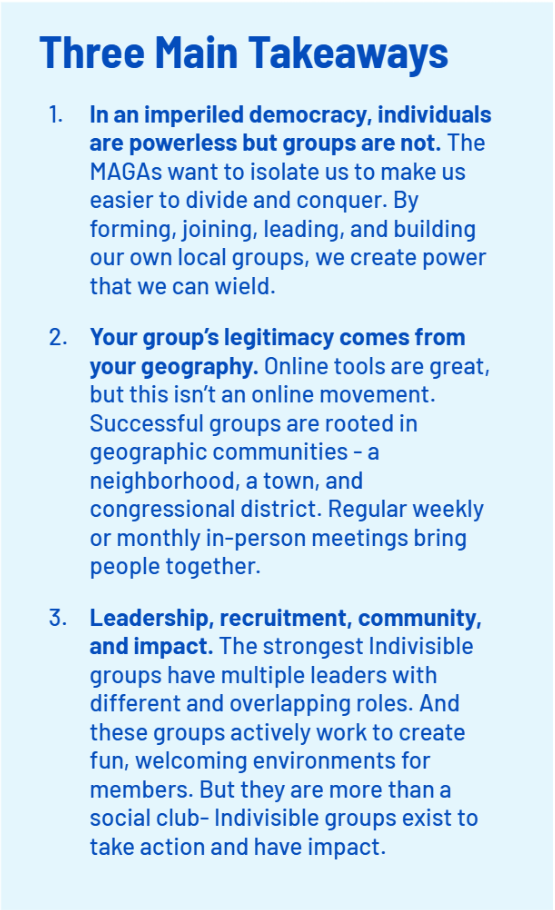
Fascists depend on you believing you’re alone and powerless. That might be true if you’re a non-rich, non-famous individual disconnected from your community. But local organized groups of individuals aren’t alone and do have power.
Eight years ago, we wrote the Indivisible Guide to help folks resist the coming Trump agenda. That Google Doc grew into a movement of thousands of locally-led volunteer Indivisible groups spread across every state, from Washington to Arizona to New York and everywhere in between. Many of those groups then built statewide coordinating groups to help them work across their states on shared goals. That movement saved the Affordable Care Act in 2017, built the largest midterm margins in history in 2018, defeated Trump in 2020, won two impossible senate runoffs in Georgia in 2021, and stopped an “inevitable” red wave in 2022.
This movement has national support from the Indivisible movement organization, but the beating heart of the movement is the local volunteer group. Every single one of these groups was started by someone or some group of people who decided to raise their hand and do the work in their own community. You can do your part by becoming a group leader yourself or joining an existing or new group to become an active member.
Note: If you are already a group leader or a group member, thank you! You can skip ahead or take a few minutes to go through the best practices, tools, and resources listed below.
Should you form a group? There are local volunteer-run Indivisible groups of all shapes and sizes in every state. Some are more active than others; some are more focused on local, state, or federal issues than others; some might be the right vibe you’re looking for or not. You can sign up hereto be connected to a local active group in your area.
If there isn’t currently an active group near you, congratulations -- you’re about to become a new Indivisible group leader. To do that, you need two things:
- A handful of people who live geographically nearby (e.g., in the same town). Some of the best Indivisible groups started tiny and became powerhouses.
- A shared commitment from those people to devote at least a few hours a month to organizing against MAGA’s anti-democratic extremism.
That’s it. The rest of this chapter is built around helping you walk through the first steps of starting that new Indivisible group!
How To Form Your New Indivisible Group
So you’ve decided to start a local group dedicated to making your electeds and your community aware of the local opposition to the MAGA agenda. Awesome. Thank you. We need you. This might be a subgroup of an existing activist group or a new effort — it really depends on your circumstances. Start where people are: if you’re in a group with a lot of people who want to do this kind of thing, then start there; if you’re not, you’ll need to find them somewhere else. The most important thing is that this is a LOCAL group. Your band of heroes is focused on applying local pressure, which means you all need to be local.
Here are five recommendations as you pull your new group together:
- Identify co-founders. Identify a few additional co-founders who are interested in participating and recruiting others. Ideally, these are people who have social networks that do not overlap too much with your own so that you can maximize your reach. Make an effort to ensure that the group's leadership reflects the diversity of opposition to Trump.
- Email your contacts, post to your social networks, and let your group chats know. Actively let folks know that you’re starting a volunteer Indivisible group for folks in the area looking to counter Trump and MAGA's coming threat.
- Invite everyone who has expressed interest to an in-person kickoff meeting. Use this meeting to agree on a name, principles for your group, roles for leadership, a way of communicating, and a strategy for your electeds and community (use Ch.2 to help!). Rule of thumb: 50% of the people who said they are definitely coming will attend your meeting. Aim high! See below for more thoughts on how to run that kickoff meeting. Don’t overthink your principles or objectives, as these are things that need to evolve over time. Some groups spend hours mulling over a mission statement that they dutifully ignore. You have too much real work to do to spend that much time on this. On the other hand, every now and then, it is a good idea to have a group meeting to refresh your raison d’etre.
- Register the group here so we can get you on the map. This is a people-powered movement, and we’re strongest when there are more of us. Your life will be easier and your group more powerful if you create a welcoming, fun space, with opportunities for people to invest their own skills and expertise into managing, growing, and leading the group.
- Have fun. Seriously. If this is a drag, people won’t do it. Indivisible groups started nearly a decade ago and are still going — not just out of a commitment to democracy but because of the warm, supportive, fun environment they became for like-minded folks. Fighting fascism is serious enough — our community spaces to organize against fascism should make us feel happy, challenged, proud, supported, and loved — not judged, less than, controlled, insignificant, or unwelcome.
Planning And Running That First Kick-Off Meeting
Gathering a group of folks together to plan how you’re going to fight back against fascism in your community might sound scary. It doesn’t have to be. You’re bringing like-minded people together. Here are some recommendations for that meeting.
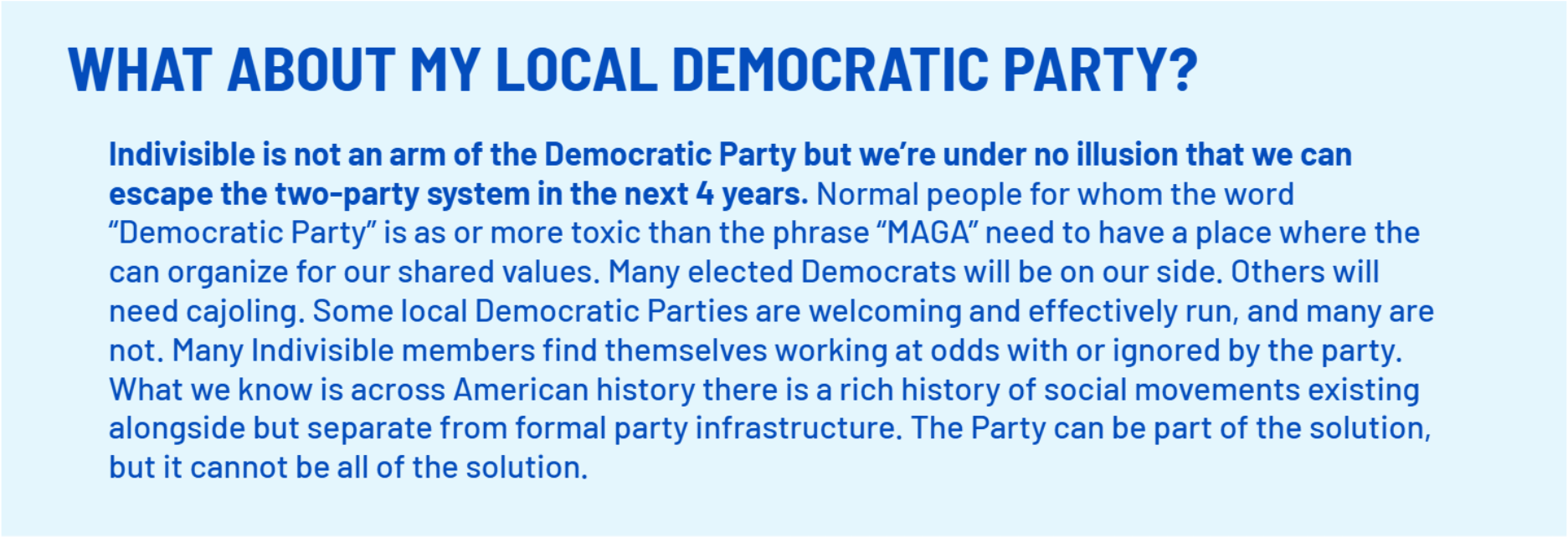
Recruit Membership
You can start with a small, close-knit group of friends, but we encourage you to think bigger. There are so many people in cities and towns across the country who are currently looking for community and a way to fight back. Your group could be exactly that. Consider talking with the people in your neighborhood who had Harris/Walz signs in their yards this cycle and asking them how they want to stay involved. You could host your first meeting in a public place like a library or a coffee shop, email the invitation to your network, and post about it on social media. Even more effective at reaching new audiences: register it on Mobilize and share the link. You may be surprised and inspired by who shows up!
Manage The Meeting With A Bias Towards Action
Keep people focused on the ultimate core strategy: using your local constituent power to help in the nationwide fight against MAGA. Other attendees may have other ideas, so affirming their concerns and feelings is essential. But it’s also important to direct everyone’s energy and make sure that the conversation stays focused on developing a group and a plan of action dedicated to this strategy. Many groups follow the internal rule that there will be a call to action at every meeting or event.
Decide On A Name For Your Group
Good names include the geographic area of your group so that it’s clear that you’re rooted in the community — e.g., “Indivisible Prescott” or “Nye County Indivisible Prickly Pears” (those are taken because they already exist, but you get the idea). It’s up to you. Run your group name through at least one search engine to see if it is already out there or would invoke something you don’t want to invoke.
Volunteer For Roles
Figure out how to divide roles and responsibilities among your group. This can look very different depending on who’s in the room. Still, at a minimum, you probably want 1-2 people in charge of overall group coordination, a designated media/social media contact, and 1-2 people in charge of tracking the electeds’ schedules and events. In addition to these administrative roles, ask attendees how they want to contribute to advocacy efforts: attend events, record events, ask questions, make calls, host meetings, engage on social media, write op-eds for local papers, etc.
Develop An In-Person Gathering Ritual
People’s lives and calendars are hectic, and the onslaught of bad news from the MAGA agenda is about to become a firehose. Successful and thriving local Indivisible groups often create a consistent in-person meeting schedule — every week or two weeks, or at least every month, to ensure that members are in regular communication and building community. Your schedule is up to you, but giving people a place they can count on is essential during a time of upheaval, and it is also a source of comfort. At your first meeting, you’ll want to set a date for the next meeting and at least tentatively agree to the frequency of meetings.
Decide How You’ll Communicate With Each Other Between Meetings
Email, group chat, Signal, Whatsapp, Discord, Slack, or others. It’s important to have a way to disseminate information and foster conversation among your whole group and among leadership members. But the best system is the one folks in your groups will use.
Consider Some Concrete First Actions
For a first meeting, you may primarily meet new people and talk about how angry you are at Trump and his billionaire backers. Sometimes, that’s what first meetups are, and you have plenty of time to scheme in the coming months. But if you’re looking for specific concrete actions, consider these ideas:
- Start with a Community Gathering Space to help folks process this election and talk through how they want to engage going forward. You can use our Gathering Guide for tips and sample agendas, messaging, and talking points for your get-together, and let us know if you’re hosting one by filling out our interest form.
- Use this guide as your, well, guide. Print out some copies in advance or encourage folks to pull it up on their phones. Then, go through each section and pull out what applies to you. What are the opportunities and challenges in your area? What do folks think would be most effective? And how are they interested in fighting back?
- Cook up something else with your group. Remember, you are the leader here. We can help, but ultimately, this comes down to entrepreneurial engagement from the grassroots. One Indivisible group in upstate NY is planning a bonfire where they write down their feelings about the election and fears for the new administration and throw them in the fire. Another group in GA is planning a potluck so they can share food together while coming up with plans for 2025. And another in Minnesota is organizing a Barn Dance to bring in new potential activists. Groups in Colorado are considering how to push their Democratic electeds to be active participants in the fight against federal MAGA.
How Indivisible National Can Help
You are not alone in this. Over the last eight years, Indivisible has developed a wide range of resources and programs to support your growing group and help you build power in your community. Most of these programs resulted from hearing from existing Indivisible groups about what they need and what would make their work even more powerful, and we are excited to share them with you.
Financial Resources
Organizing and running an Indivisible group should be as accessible as possible. To get you started and level up your work, Indivisible offers several support programs to help fund your work.
- Our distributed fundraising program provides your Indivisible group with the tools it needs to raise and spend funds. You can spend the funds you raise through this program on general group costs like Zoom or a website, outreach and community events, advocacy work, and more.
- Our GROW Grants program provides direct financial support for Indivisible groups’ collaborative and capacity-building projects. Indivisible groups can apply for grant money for projects, supplies, trainings, vendors, and more.
- Our IndivisiGather program helps reimburse groups that want to host fun, non-advocacy-based activities with their members and community. These gatherings can be structured around group retreats, barbecues, ice cream socials, coffee chats, book clubs, game nights, beach gatherings, hikes, virtual get-togethers, etc.
- Last, we offer reimbursements for major movement moments like Weeks of Action, big advocacy campaigns, or electoral work. Stay in touch with us through your organizer or our group leader email list to find out about these opportunities.
Organizing Support
We are here to help you build and run your group so you can be as effective and powerful as possible. You can access the Group Support Hub, which has an array of helpful resources. Indivisible has a team of organizers spread around the country to answer questions, help you plan actions, and work through any tricky organizing challenges. They can also help you navigate all the different programs and resources available to groups. To connect to your local organizer, please contact supportteam@indivisible.org (and don’t be surprised if they reach out to you after you register your group on the map).
In addition to our incredible team of organizers, we offer national trainings on organizing topics like “How to Start a New Group,” “Effective Recruitment Strategies,” and “Building a Strong Leadership Team.” Look out for our Organizing Office Hours in 2025!
Press Help
Generating earned media is a huge part of how local groups influence their legislators and fight for change. And journalists are always on the lookout for local hooks to connect to national stories, and you can be that hook for them! Our press team can help you get started by providing you with a media list for your area, helping you draft media advisories and press releases, practicing for interviews, and even pitching reporters for your upcoming events. For more information, please reach out to press@indivisible.org
Strategic Guidance and Calls to Action
We are determined to help you figure out the absolute best ways to engage in thwarting the Trump agenda, stand in solidarity with targeted communities, and build your local power. Through our emails, national calls, and conversations with your organizer, we will give you our best advice and calls to action. This could look like working with groups in Blue States to push forward a proactive agenda, protesting unpopular legislation during a national Week of Action, or participating in a surgical campaign targeting vulnerable Republicans.
Connecting with Other Local Indivisible Groups
Indivisible groups and group leaders are awesome. One of the amazing benefits of being a group leader is connecting with other group leaders across the country. Whether through our Raucous Rural Caucus, our National BIPOC Caucus, or different community spaces, you can learn and grow in community with other Indivisible group leaders. And have a question about a specific tactic? Or just want to connect with the groups in your region? Your Indivisible organizer can help with that!
Conclusion
“Don't mourn. Organize.” -- an old labor saying
If you’re reading this, you’re probably holding a lot right now. You might be overcome with sorrow or anger at Vice President Harris’ loss. You might be feeling betrayed by the leadership and institutions that got us here. You might be consumed with fear for yourself, your friends and family, and your community. You might be feeling overwhelmed by the dangers ahead. You might be feeling all of these things.
But we’re going to bet — because you just voluntarily read all the way through a thirty-page screed about civics — that you’re also feeling something else: determined.
Indivisible is a movement for people who are determined — people who turn fear, anger, and grief into action. People who come together in community to hold each other up, protect each other, and fight for our values. If that sounds like you, we invite you to join us.
We can’t tell you that everything will work out OK over the coming years—no one can. But we can tell you with a lot of confidence that nothing will be OK unless we fight for it.
And there’s so much that’s worth fighting for.
We wrote this guide now because when you’re going through hell, you keep going. We can’t tell you that we have all the answers. But we can share our belief that you — we — have power. So right now, we grit our teeth, look steadfastly ahead, put one foot in front of the other, and say loudly so others nearby who are doubting can hear: we will win.
